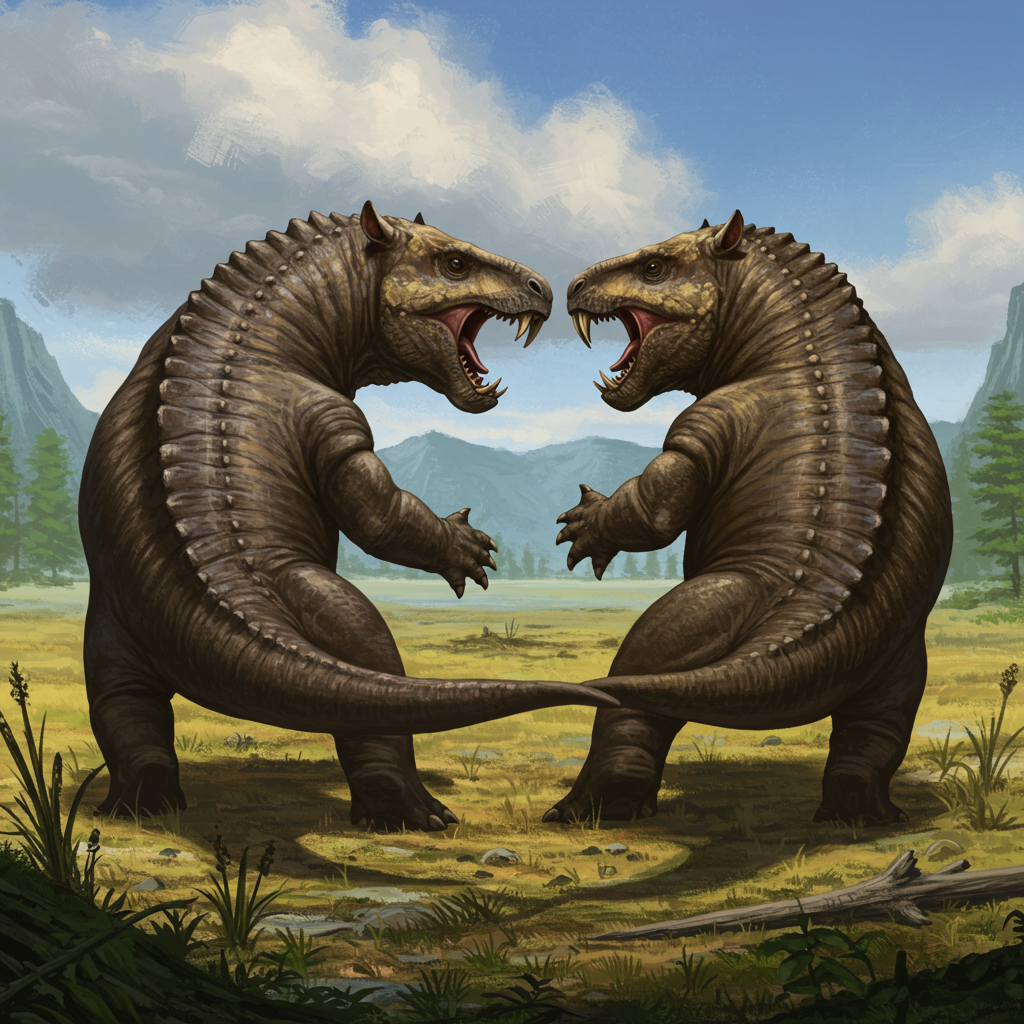Long before the age of Tyrannosaurus rex and Velociraptor, Earth was ruled by super-carnivores far stranger and arguably more terrifying than anything modern movies have depicted. Welcome to the Permian period, a prehistoric era where formidable beasts with sabre-teeth, bone-crushing jaws, and bizarre body plans stalked the supercontinent Pangaea.
Imagine a scene from this ancient world: Two powerful predators, built with robust bodies and thick, rhino-like skin, circle each other. Their jaws gape wide, revealing terrifying sabre-teeth like sharpened steak knives. They lunge. A tooth shears off, embedding itself in the opponent’s snout. This brutal confrontation, though millions of years in the past, left behind fossil evidence that offers chilling glimpses into the violent lives of these creatures.
Palaeontologist Julien Benoit experienced one such moment on a sunny day in 2021 while sorting through mislabelled fossil collections in Cape Town, South Africa. Inside an old cardboard box, he discovered a small, shiny surface – a tooth embedded in a skull. It belonged to an unidentified species of gorgonopsian, a group of apex predators that hunted roughly 250 to 260 million years ago. This fossil fragment was a tangible link to a world that existed long before the most famous dinosaurs walked the Earth.
A World of Extremes: The Permian Environment
The Permian period, spanning from approximately 299 to 251 million years ago, was an era defined by dramatic environmental shifts. All the Earth’s major landmasses had coalesced into the single, vast supercontinent called Pangaea, surrounded by the global ocean, Panthalassa.
The period began with an ice age, causing sea levels to drop significantly. As the climate warmed, much of Pangaea’s vast interior became arid, turning into scorching deserts with temperatures potentially reaching 73°C (163°F). While the edges and higher latitudes retained more moisture and vegetation, these extreme conditions shaped the evolution of life.
Towards the Permian’s end, the planet experienced an abrupt and significant global warming event, increasing average temperatures by about 10°C (60°F). This drastic climate change set the stage for the largest mass extinction event in Earth’s history, known as the Great Dying.
The Rise of the Synapsids
During the Permian, the dominant land animals were not dinosaurs – they were synapsids. This incredibly diverse group, which included everything from moose-sized herbivores like Cotylorhynchus with its tiny head, to the bizarre, hippo-like Estemmenosuchus, exhibited a kaleidoscopic array of forms unlike anything seen before.
Synapsids had crucial evolutionary advantages over the amphibians that preceded them. They were among the first four-legged animals to become truly independent of water for reproduction, either through internal incubation or laying large, moisture-retaining eggs – essentially carrying their own “private pond.” They also developed waterproofing on their bodies, allowing them to inhabit diverse terrestrial environments.
Crucially, synapsids evolved differentiated teeth, like incisors and canines, a significant upgrade from the rows of similar-shaped teeth found in their ancestors. This “Swiss Army knife” mouth allowed herbivores to efficiently process tougher, more nutritious plants, leading to larger body sizes. These larger herbivores, in turn, provided a rich food source for carnivores, enabling predators to also grow to immense sizes and quickly dominate the landscape.
Beyond the synapsids, the Permian world was filled with other peculiar life forms, including duck-sized dragonflies (Meganeuropsis), 10-meter-long carnivorous amphibians with snapping snouts, and the bizarre shark-like Helicoprion, armed with a unique circular saw of teeth used to slice through prey.
Giants Among Them: Meet the Permian’s Top Predators
The supercontinent Pangaea was teeming with massive flesh-eaters, each uniquely adapted to this challenging world.
Dimetrodon: Often mistaken for a dinosaur, Dimetrodon was a synapsid predator up to 3.5 times larger than a modern Komodo dragon, weighing up to 250kg. These apex predators are instantly recognizable by the tall, radiating “sail” on their backs. While early theories suggested the sail was used for sailing or rapid thermoregulation, research indicates it was likely too inefficient for warming and may have even risked heat loss in smaller species. The prevailing idea today is that the sail served a display function, possibly for courtship. Fossil evidence from sites in Texas initially showed a surprisingly high ratio of Dimetrodon to large prey, suggesting a potential “meat shortage” on land. This mystery was partially solved with discoveries showing Dimetrodon teeth mixed with shark skeletons, indicating they supplemented their diet by hunting large freshwater Xenacanthus sharks – and were sometimes preyed upon by them in return. Later Dimetrodon evolved serrated, curved, and replaceable teeth, allowing them to tackle increasingly larger prey by tearing off chunks of flesh.
Anteosaurus: The largest predator of the mid-Permian, Anteosaurus grew up to 6 meters (19.7 ft) long, resembling a terrifying hybrid of a tiger and a hippo. These dominant carnivores, with muscular jaws, powerful arms, and bone-crushing teeth, ruled across Pangaea around 260-265 million years ago. Bony ridges above their eye sockets gave them a formidable appearance, and their heads were remarkably well-designed for killing large animals and crushing bones. Studies of the Anteosaurus inner ear revealed adaptations for balance and agility comparable to modern cheetahs or Velociraptor, suggesting they were surprisingly fast hunters despite their massive size. They also possessed traits indicating impressive gaze stabilization, allowing them to relentlessly track prey once locked on. However, the reign of Anteosaurus was relatively short-lived, ending in a mass extinction event around 260 million years ago.
Gorgonopsians: Succeeding Anteosaurus as the top predators were the gorgonopsians, featuring the mighty Inostrancevia. These formidable hunters possessed sabre-fangs that could reach 20-30cm (8-12 inches) including the root, housed in skulls up to 70cm (2.3ft) long. With body proportions suggesting speed and power, Inostrancevia were likely ambush predators, leaping from cover to subdue large herbivores like dicynodonts and pareiasaurs. They would use their powerful jaws and terrifying fangs to tear off chunks of flesh, which they swallowed whole as they were incapable of chewing. A key advantage Inostrancevia held over later sabre-toothed cats was the ability to easily replace lost or broken teeth, crucial for surviving their brutal hunting style.
Ecosystems Under Strain: A Warning from the Past
Many fossil finds of Inostrancevia and other gorgonopsians come from South Africa’s Karoo basin. Today a dry, open plain, 250 million years ago the Karoo was a relatively lush landscape centered around an inland sea, supporting vast herds of prey animals.
Until recently, Inostrancevia was only known from Russia, across the vast expanse of Pangaea. The discovery of Inostrancevia in the Karoo, previously thought to be exclusively home to smaller gorgonopsians, revealed something significant. The smaller local predators had gone extinct before the peak of the Great Dying. Inostrancevia migrated across the supercontinent to fill this ecological void.
For palaeontologists like Christian Kammerer, this wasn’t just an interesting fossil distribution; it was an ominous sign. It showed that ecosystems were becoming destabilized and undergoing significant changes well before the main extinction pulse hit. Predators were disappearing and being rapidly replaced by new arrivals.
Kammerer points out that this holds a lesson for today’s biodiversity crisis. The loss of apex predators can lead to unexpected ecological shifts, such as the rise of formerly mid-tier predators filling the gap. This can be seen in parts of North America where, following the historical decline of bears, pumas, and wolves, coyotes have become dominant, aggressively expanding their range and taking over the role of top predator in some areas.
The Great Dying and a Lasting Legacy
Ultimately, even the mighty Inostrancevia* and all other gorgonopsians, along with the vast majority of Permian synapsids, perished in the Great Dying 251 million years ago. Triggered by massive volcanic eruptions in the Siberian traps that pumped enormous amounts of CO2 into the atmosphere, global temperatures soared, leading to ocean stagnation and deoxygenation, devastating marine life, and causing widespread collapse of terrestrial ecosystems. This extinction event, unfolding over hundreds of thousands of years rather than instantaneously like the asteroid impact that ended the dinosaur age, wiped out around 90% of all life on Earth.
However, a tiny handful of synapsid species managed to survive the Permian-Triassic extinction, clinging to existence in the ravaged world of the early Triassic. These survivors carried the legacy of the Permian monsters. Eventually, they would evolve warm-bloodedness, fur, and the ability to feed their young milk.
The strange, terrifying predators that ruled the Earth before the dinosaurs were not just a fascinating chapter in prehistory; they were our distant ancestors. The synapsids that endured the Great Dying are the lineage from which all mammals alive today, including us humans, eventually arose.



